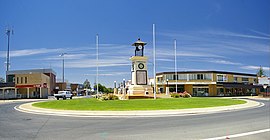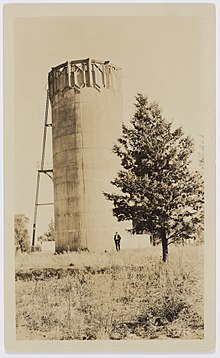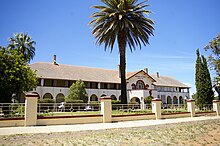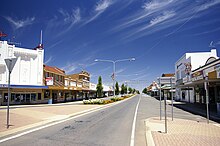Leeton, New South Wales
 From Wikipedia - Reading time: 17 min
From Wikipedia - Reading time: 17 min
This article needs additional citations for verification. (July 2018) |
| Leeton New South Wales | |||||||||
|---|---|---|---|---|---|---|---|---|---|
 Leeton War Memorial | |||||||||
| Coordinates | 34°34′0″S 146°24′0″E / 34.56667°S 146.40000°E | ||||||||
| Population | 7,437 (2021 census)[1] | ||||||||
| Established | 2 April 1913 | ||||||||
| Postcode(s) | 2705 | ||||||||
| Elevation | 138.3 m (454 ft) | ||||||||
| Location |
| ||||||||
| LGA(s) | Leeton Shire | ||||||||
| County | Cooper | ||||||||
| Parish | Willimbong | ||||||||
| State electorate(s) | Murray | ||||||||
| Federal division(s) | Farrer | ||||||||
| |||||||||
Leeton is a town located in the Riverina region of New South Wales, Australia. It is situated in the Murrumbidgee Irrigation Area.[2] It is the administrative centre of the Leeton Shire Council local government area, which includes neighbouring suburbs, towns and localities such as Yanco, Wamoon, Whitton, Gogeldrie, Stanbridge and Murrami.[2][3][4]
The town was designed by Walter Burley Griffin and built for the New South Wales government early 20th century irrigation schemes. Leeton is home to citrus, rice, cotton, grape, walnut, and wheat farming. It is known as Australia's Rice Capital, as well as The Heart of SunRice Country, as it is home to the headquarters of SunRice corporation, one of Australia's largest food exporters.[5][6] Other industry includes Arnott's Biscuits (previously Freedom Foods),[7] Webster Limited,[8] and Murrumbidgee Irrigation Limited.[9]
Tony Reneker is the current mayor of Leeton.[10][11]
History
[edit]
Prior to European colonisation, the area was inhabited by the Wiradjuri people. The town is named after Charles Alfred Lee, a Minister for Public Works in New South Wales from 1904 to 1910.[12][13]

In 1912 a water tower was built to supply water to the town.[14] Leeton Post Office opened on 6 September 1912.[15]
When the Water Conservation and Irrigation Commission of New South Wales was formed on 1 January 1913, Leeton was a canvas town, with the only houses being on farms built by settlers or the Commission-built homes for officers.[16]
On 22 January 1913, under the provisions of the Crown Lands Act of 1884, Leeton was declared a town by the Department of Lands, Sydney.[17]
The first block of land was sold in the town April 3, 1913. In1913, a Kurrajong tree (later known as Pioneers' Tree), was planted as a central feature on the eponymous Kurrajong Avenue, and a butter factory was established in the town.[18] In August of the same year, Walter Burley Griffin visited the town to complete its design.[14][19]
In 1914, World War I broke out; of the town's population of 2,000 people, 200 men were serving in the military. During 1914 and 1915 an abattoir and canning factory were established in the town.[18]

In 1919, the Hydro Hotel was constructed for Water Conservation and Irrigation Commission executives to stay whilst in Leeton, but was not licensed to sell alcohol until 1924 when the alcohol prohibition in the Murrumbidgee Irrigation Area was lifted.[20]
During 1920, the Water Conservation and Irrigation Commission of New South Wales began to pressure the Government for relief for being responsible for providing civic and local government services with the Commission stating "revenue which comes mainly from rents and water charges, having remained unchanged, is insufficient to cover the cost of local government services now that the weekly wage is more than double the figure paid when the settlement started".[21] The Commission chose and appointed an advisory board which was made up of pioneer farmers which already had been in operation in the Yanco area since 1913. In June 1925 the Commission released its annual report stating that a Royal Commission recommended setting up of local government bodies within the Murrumbidgee Irrigation Area but no date had been decided.[21]
1 January 1928, the Willimbong Shire was formed with the name "Willimbong" being retained until 19 July 1946 when it was renamed as Leeton Shire.[22]

In 1929 the Roxy Theatre was built on a large vacant block of land on the corner of Wade and Pine Avenue and was completed and opened in April 1930.[23]
In 1930 Willimbong Shire become the trustee of the Leeton Racecourse, established in 1912, when the land was appropriated as a reserve for racing, public recreation and aviation. In August 1931 Southern Cross became the first aircraft to officially land at the aerodrome. During 1935, the aerodrome was refurbished to the standard that qualified it to base and fly commercial .[24] In August 1935, Western and Southern Provincial (W.A.S.P.) Airlines commenced an air service between Leeton and Sydney. However the service was ended in 1936 when a Tugan Gannet aircraft used by W.A.S.P. Airlines crashed on 26 February 1936 in the Cordeaux Dam area.[24]
In July 1938 it was proposed to the Willimbong Shire by the Civil Aviation Board that the area around Fivebough could be developed into an aerodrome since the Leeton Aerodrome at the race course was too small and could only operate on a restricted license.[24] Willimbong Shire agreed to lease the land with preliminary work carried out on the site but the aerodrome was never used by any commercial airline.[24]
During World War II, the Royal Australian Air Force established a training school in the nearby town of Narrandera which was a large aerodrome. After this, a report from the Department of Civil Aviation stated that Fivebough was eminently suitable as an aerodrome but strongly recommended that they should consider jointly operating the aerodrome with Narrandera Shire.[24]
During the early part of the 1930s Willimbong Shire took over the town water supply when it became apparent that the town needed a second water tower which was completed next to the first tower on 27 March 1937.[14]

The swimming baths in Leeton were constructed by voluntary labour and were completed on 24 February 1932.[25] The Leeton Swimming Club made a request that the swimming baths be replaced by a modern swimming complex. In 1959 money was raised though the Irrigana Festival, a biennial festival in the town, and the Leeton Shire obtained a loan.[25] On 17 November 1962 the Leeton & District Memorial Swimming Pool was opened.[25]
Rice growing became a major industry during World War II, under government promotion to help supply food for troops. A number of local farmers, such as teenager Norm Houghton, pioneered the planting of new varieties to suit the local conditions.[26] The Irrigana Festival began in 1959 as a biennial event but was short lived due to a lack of strong publicity value. The name "Irrigana" was chosen from a competition in the Murrumbidgee Irrigator.[27] In 1970 a similar festival returned in the town, known as the "Rice Bowl Festival", and by 1988 the festival was renamed to "Sunwhite Rice Festival" with sponsorship from the Ricegrowers Co-Operative Limited.[27]
Heritage listings
[edit]Leeton has a number of heritage-listed sites, including:
- Hydro Hotel[28]
- Koonadan Historic Site[29]
- Leeton District Lands Office[30]
- Leeton District Office artefacts[31]
- Leeton railway station[32]
- Roxy Community Theatre[33]
Education
[edit]
Leeton is the second largest educational centre in the Riverina after Wagga Wagga.
Leeton Shire has three secondary schools:
Leeton Shire has six primary schools:
- Leeton Public School
- Parkview Public School
- St Joseph's Primary School
- Wamoon Public School
- Yanco Public School
- Whitton Public School
Other education includes:
- TAFE NSW Riverina Institute
- Murrumbidgee College of Agriculture
- Gralee Support School
- MET School (Leeton Campus)
- Leeton Pre-School
- Leeton Early Learning Centre
- Goodstart Early Learning
Climate
[edit]Leeton has a cold semi-arid climate (BSk), with hot, dry summers and cool, partly cloudy winters.[34] It features 137.7 clear days annually.[35]
| Climate data for Leeton Caravan Park (1913−1975, rainfall to 2005); 140 m AMSL; 34.57° S, 146.41° E | |||||||||||||
|---|---|---|---|---|---|---|---|---|---|---|---|---|---|
| Month | Jan | Feb | Mar | Apr | May | Jun | Jul | Aug | Sep | Oct | Nov | Dec | Year |
| Record high °C (°F) | 44.3 (111.7) |
43.9 (111.0) |
38.3 (100.9) |
32.4 (90.3) |
27.2 (81.0) |
28.3 (82.9) |
25.2 (77.4) |
25.0 (77.0) |
33.5 (92.3) |
36.0 (96.8) |
41.4 (106.5) |
42.2 (108.0) |
44.3 (111.7) |
| Mean daily maximum °C (°F) | 31.9 (89.4) |
31.2 (88.2) |
28.2 (82.8) |
22.9 (73.2) |
18.1 (64.6) |
14.7 (58.5) |
13.9 (57.0) |
15.8 (60.4) |
19.3 (66.7) |
23.0 (73.4) |
27.0 (80.6) |
30.2 (86.4) |
23.0 (73.4) |
| Mean daily minimum °C (°F) | 17.2 (63.0) |
17.2 (63.0) |
14.6 (58.3) |
10.4 (50.7) |
7.0 (44.6) |
4.6 (40.3) |
3.7 (38.7) |
4.6 (40.3) |
6.6 (43.9) |
9.7 (49.5) |
12.7 (54.9) |
15.6 (60.1) |
10.3 (50.5) |
| Record low °C (°F) | 8.4 (47.1) |
7.8 (46.0) |
3.9 (39.0) |
1.7 (35.1) |
−1.2 (29.8) |
−3.9 (25.0) |
−3.9 (25.0) |
−3.2 (26.2) |
−2.7 (27.1) |
0.6 (33.1) |
4.0 (39.2) |
6.1 (43.0) |
−3.9 (25.0) |
| Average precipitation mm (inches) | 32.4 (1.28) |
30.6 (1.20) |
33.1 (1.30) |
35.0 (1.38) |
39.2 (1.54) |
39.8 (1.57) |
37.1 (1.46) |
40.9 (1.61) |
37.4 (1.47) |
44.7 (1.76) |
30.8 (1.21) |
31.2 (1.23) |
432.3 (17.02) |
| Average rainy days | 4.0 | 3.7 | 4.0 | 5.1 | 7.2 | 8.6 | 9.6 | 9.6 | 7.7 | 7.3 | 5.0 | 4.7 | 76.5 |
| Source: [36] | |||||||||||||
Transport
[edit]
Leeton is approximately 450 km from Melbourne along the Newell, Goulburn Valley and Hume Highways and 550 km from Sydney along the Sturt and Hume Highways. There are daily flights leaving Narrandera Airport, operated by Regional Express.[37] The airport is located near the shire boundary, approximately 20 km from the CBD. There are coach services to Sydney and Adelaide, leaving Leeton Coach Terminal in Gidgee Street daily. NSW TrainLink also operates coach services to Wagga Wagga connecting with XPT services to Sydney and Melbourne. An Xplorer service to Griffith calls at Leeton railway station on Wednesday and Saturday, with the return service to Sydney calling on Thursday and Sunday.
Industry
[edit]The processing of agricultural products comprises Leeton's largest industry.[9] Ricegrowers Limited, operating as SunRice and CopRice, is by far Leeton's largest employer. Its international headquarters are located in the town, as well a rice mill and manufacturing plants. Other major companies include The Daily Juice Company, JBS Australia (as a subsidiary of JBS S.A.), Murrumbidgee Irrigation Limited, Pacific Fresh,Toorak Wines, Lillypilly Wines and Southern Central Engineering, as well as the Arnott's Group,[7] located in Stanbridge, and Southern Cotton, located in Whitton.[9][38]
The Vance Industrial Estate houses many smaller scale industrial companies.[39]
Attractions
[edit]
Leeton has a number of town landmarks, including the Roxy Theatre, War Memorial, Madonna Place, St Peter's Church and The Burley Griffin water towers.
Outdoors
[edit]The Ramsar-listed Fivebough and Tuckerbil Wetlands as well as the nearby Murrumbidgee River and Murrumbidgee Valley National Park provide ample opportunities for bushwalking and birdwatching.[40][41]

Media
[edit]Leeton's town newspaper The Irrigator (formerly known as The Murrumbidgee Irrigator) is released throughout the region on Tuesday and Friday.[6] Local radio stations are ABC Riverina on 100.6 FM, Star FM on 99.7 FM and 2RG. WIN Television also broadcasts the local news of the Riverina on weeknights.
Sport
[edit]The Leeton Greens play rugby league in the Group 20 Rugby League competition and have won eight premierships. The club was founded in the 1920s[42] and play on Leeton No 1 Oval.[43] They are the current reigning premiers as of 2022.[44]
The Leeton-Whitton Crows play Australian rules football in the Riverina Football League and were formed by a merger of the Leeton Redlegs and Whitton-Yanco Tigers in 1995.[45] They won their first premiership since the merger in 2017, breaking a 39-year premiership drought.[46]
Leeton United Football Club play soccer in the Griffith District Football Association and were formed in 1962.[47]
Notable citizens
[edit]Notable citizens originating from Leeton include:
- Kurt Aylett - Australian rules footballer[48]
- Linda Burney (Current Minister for Indigenous Australians and federal MP for the Division of Barton,[49] and former deputy leader of the NSW Labor Party and state MP for Canterbury[50])
- John Faulkner (Australian Labor Party Senator)[51]
- Matthew Dunn (Three-time Olympic swimmer (Barcelona 1992, Atlanta 1996, Sydney 2000) and seven-time Commonwealth Games gold medallist)[52]
- Ross Elwin, Australian rules footballer[53]
- Rod Maybon (National Rugby League footballer)
- Robert McLachlan (professional road bicycle racer)
- Peter Peters (National Rugby League footballer and commentator)
- Jay Bandy (former National Rugby League player)
- Mathew Feagai (National Rugby League player)
- Max Feagai (National Rugby League player)
- Clint Halden (former National Rugby League player)[citation needed]
- Jeff Robson (former National Rugby League player)[54][55]
- Mark Taylor (Former captain of the Australia national cricket team, cricketer, and commentator)[56]
- Helen Wellings (consumer advocate)[57]
- Craig Nettelbeck (Former Australian Football League footballer)
- Max Kruse (Former VFL footballer)
- Jacob Hopper (AFL footballer)[58]
- Cooper Sharman, Australian rules footballer[59][60]
- Jacob Townsend (Former AFL and current VFL footballer).[61][62]
Australian poet and writer Henry Lawson lived in Leeton for two years, from 1916 to 1917. Lawson had been hired to write about the Murrumbidgee Irrigation Area to attract settlers to the area.[63][64]
References
[edit]- ^ Australian Bureau of Statistics (28 June 2022). "Leeton". 2021 Census QuickStats. Retrieved 19 March 2023.
- ^ a b "Leeton". Walkabout. Archived from the original on 20 July 2008. Retrieved 20 March 2008.
- ^ "About the Shire". Leeton Shire Council. Archived from the original on 21 February 2008. Retrieved 20 March 2008.
- ^ "History". Leeton Shire Council. Retrieved 30 May 2018.
- ^ "Fine Food & Wine". Riverina Regional Tourism. Archived from the original on 19 July 2008. Retrieved 28 August 2008.
- ^ a b "The Irrigator" (PDF). Fairfax Media. Riverina Media Group. Archived from the original (PDF) on 6 July 2011. Retrieved 19 August 2008.
- ^ a b "Freedom Foods completes sale of Cereal and Snacks to The Arnott's Group, reports 3Q results". Convenience & Impulse Retailing Magazine. 6 May 2021. Retrieved 20 May 2021.
- ^ "Webster Annual Report 2017" (PDF).
- ^ a b c "Industry and Investment". Leeton Shire Council. Retrieved 30 May 2018.
- ^ Pattison, Talia (23 December 2021). "Councillor Tony Reneker elected as Leeton shire mayor, councillor Michael Kidd the new deputy mayor". The Irrigator. Retrieved 30 October 2022.
- ^ "Mayor Cr Tony Reneker". www.leeton.nsw.gov.au. Retrieved 28 March 2024.
- ^ "Place names". The Australian Women's Weekly. National Library of Australia. 13 May 1964. p. 61. Retrieved 22 February 2011.
- ^ Leeton Tourism: Charles Alfred Lee Archived 18 February 2011 at the Wayback Machine, accessed 22 February 2011.
- ^ a b c Maguire, Marie (1988). Local Government in Leeton 1928–1988. Leeton Shire Council. p. 14. ISBN 0959991611.
- ^ Phoenix Auctions History. "Post Office List". Retrieved 24 January 2021.
- ^ Maguire, Marie (1988). Local Government in Leeton 1928–1988. Leeton Shire Council. p. 7. ISBN 0959991611.
- ^ "TOWN OF LEETON". Government Gazette of the State of New South Wales. 22 January 1913. Retrieved 13 December 2023.
- ^ a b Maguire, Marie (1988). Local Government in Leeton 1928–1988. Leeton Shire Council. p. 8. ISBN 0959991611.
- ^ Maguire, Marie (1988). Local Government in Leeton 1928–1988. Leeton Shire Council. p. 21. ISBN 0959991611.
- ^ "Leeton". Australian Heritage magazine. Hallmark Editions. Retrieved 7 March 2009.
- ^ a b Maguire, Marie (1988). Local Government in Leeton 1928–1988. Leeton Shire Council. p. 9. ISBN 0959991611.
- ^ Maguire, Marie (1988). Local Government in Leeton 1928–1988. Leeton Shire Council. p. 10. ISBN 0959991611.
- ^ Maguire, Marie (1988). Local Government in Leeton 1928–1988. Leeton Shire Council. p. 41. ISBN 0959991611.
- ^ a b c d e Maguire, Marie (1988). Local Government in Leeton 1928–1988. Leeton Shire Council. p. 39. ISBN 0959991611.
- ^ a b c Maguire, Marie (1988). Local Government in Leeton 1928–1988. Leeton Shire Council. p. 35. ISBN 0959991611.
- ^ Peter Lalor, 'Rice growers resent water-wasting image', The Australian, 11 Nov 2006 (registration required)
- ^ a b Maguire, Marie (1988). Local Government in Leeton 1928–1988. Leeton Shire Council. p. 47. ISBN 0959991611.
- ^ "Hydro Hotel". New South Wales State Heritage Register. Department of Planning & Environment. H00247. Retrieved 18 May 2018.
 Text is licensed by State of New South Wales (Department of Planning and Environment) under CC BY 4.0 licence.
Text is licensed by State of New South Wales (Department of Planning and Environment) under CC BY 4.0 licence.
- ^ "Koonadan". Office of Environment and Heritage. Retrieved 4 June 2019.
- ^ "Leeton District Lands Office". New South Wales State Heritage Register. Department of Planning & Environment. H00965. Retrieved 18 May 2018.
 Text is licensed by State of New South Wales (Department of Planning and Environment) under CC BY 4.0 licence.
Text is licensed by State of New South Wales (Department of Planning and Environment) under CC BY 4.0 licence.
- ^ "Leeton District Office - Artefacts in Reception Lobby Showcase 1". New South Wales State Heritage Register. Department of Planning & Environment. H00966. Retrieved 18 May 2018.
 Text is licensed by State of New South Wales (Department of Planning and Environment) under CC BY 4.0 licence.
Text is licensed by State of New South Wales (Department of Planning and Environment) under CC BY 4.0 licence.
- ^ "Leeton Railway Station and yard group". New South Wales State Heritage Register. Department of Planning & Environment. H01178. Retrieved 18 May 2018.
 Text is licensed by State of New South Wales (Department of Planning and Environment) under CC BY 4.0 licence.
Text is licensed by State of New South Wales (Department of Planning and Environment) under CC BY 4.0 licence.
- ^ "Roxy Community Theatre". New South Wales State Heritage Register. Department of Planning & Environment. H01747. Retrieved 18 May 2018.
 Text is licensed by State of New South Wales (Department of Planning and Environment) under CC BY 4.0 licence.
Text is licensed by State of New South Wales (Department of Planning and Environment) under CC BY 4.0 licence.
- ^ "Leeton" (PDF). C Change Bureau. Archived from the original (PDF) on 19 July 2008. Retrieved 2 February 2009.
- ^ "Australian climatic zones". Australian Government. Bureau of Meteorology. Archived from the original on 4 December 2008. Retrieved 21 December 2008.
- ^ "Summary statistics Leeton Caravan Park". Bureau of Meteorology. Commonwealth of Australia. 2 June 2011. Retrieved 5 June 2011.
- ^ "Getting to Leeton". Leeton Shire Council. Retrieved 8 May 2020.
- ^ "Agriculture". Leeton Shire Council. Retrieved 30 May 2018.
- ^ Hopper, Rebecca (9 November 2016). "Vance Industrial Estate welcomes NBN". The Irrigator. Retrieved 8 May 2020.
- ^ "Fast Facts". Leeton Shire Council. Retrieved 30 May 2018.
- ^ "Fivebough Ramsar Wetlands". Leeton Shire Council. Retrieved 30 May 2018.
- ^ Habermann, Elizabeth (25 June 2021). "Leeton Greens ready to celebrate clubs's 100-year history". The Irrigator. Retrieved 19 March 2023.
- ^ "Leeton Sport & Recreation Precinct". Leeton Shire Council. Retrieved 19 March 2023.
- ^ Warren, Liam (18 September 2022). "Leeton Greens claim 2022 Group 20 first grade premiership". The Area News. Retrieved 19 March 2023.
- ^ "Leeton Whitton". Australian Football. Retrieved 19 March 2023.
- ^ Braybon, Sarah (25 September 2017). "Crows end 39 – Year Premiership Drought". AFL Riverina. Retrieved 19 March 2023.
- ^ "Leeton United Football Club". Leeton Shire Council. Retrieved 19 March 2023.
- ^ Kurt Aylett says return to Essendon unlikely despite player suspensions By Matt Malone 13 January 2016
- ^ "Hon Linda Burney MP". Parliament of Australia. Retrieved 2 December 2023.
- ^ "The Hon. Linda Jean BURNEY". Parliament of New South Wales. Retrieved 2 December 2023.
- ^ "former Senator the Hon John Faulkner". Senators and Members of the Parliament of Australia. Retrieved 7 November 2021.
- ^ "The WADA Interview - Matthew Dunn". World Anti-Doping Agency.
- ^ Holmesby, Russell; Main, Jim (2014). The Encyclopedia of AFL Footballers: every AFL/VFL player since 1897 (10th ed.). Seaford, Victoria: BAS Publishing. p. 259. ISBN 978-1-921496-32-5.
- ^ "Jeff Robson - Career Stats & Summary - Rugby League Project". Rugby League Project. Retrieved 8 May 2020.
- ^ Ritchie, Dean. "Parramatta turn to Jeff Robson at halfback". The Daily Telegraph. Retrieved 8 May 2020.
- ^ Byrne, Shannon; Coleman, Chris. "Leeton's Mark Taylor inducted into Australia's cricket hall of fame". ABC.net.au. Retrieved 8 May 2020.
- ^ Kent, Simon (19 July 1992). "Helen Wellings "without fear or favour"". The Sydney Morning Herald. Retrieved 6 May 2020.
- ^ Cordy, Neil. "GWS Rising Star Jacob Hopper out of the wilderness and into the AFL spotlight". Daily Telegraph.
- ^ AFL Record. Round 13, 2022. pg 68
- ^ "From 'Rocket' rockets to a draft bolter — and a desire to prove Giants wrong". Fox Sports. 20 November 2019. Retrieved 22 August 2021.
- ^ Byrne, Shannon. "Jacob Townsend signs with Team GWS". ABC.net.au.
- ^ "Jacob Townsend". Southport Sharks. Southport Sharks Football Club. Archived from the original on 2 December 2023. Retrieved 2 December 2023.
- ^ "Images of Henry Lawson". University of Sydney Library. 26 May 2011. Archived from the original on 16 June 2011. Retrieved 5 June 2011.
- ^ "Henry Lawson". Leeton Shire Council. Retrieved 17 July 2015.
External links
[edit]- Leeton Shire Council – council website
- Leeton Visitors Information Centre
 KSF
KSF